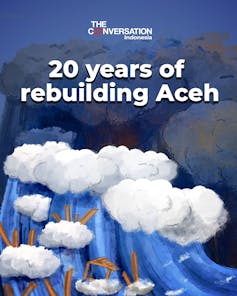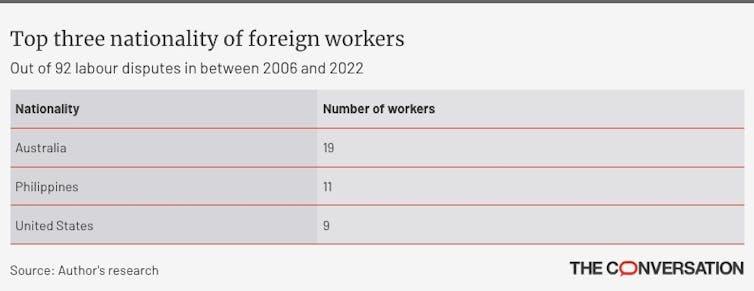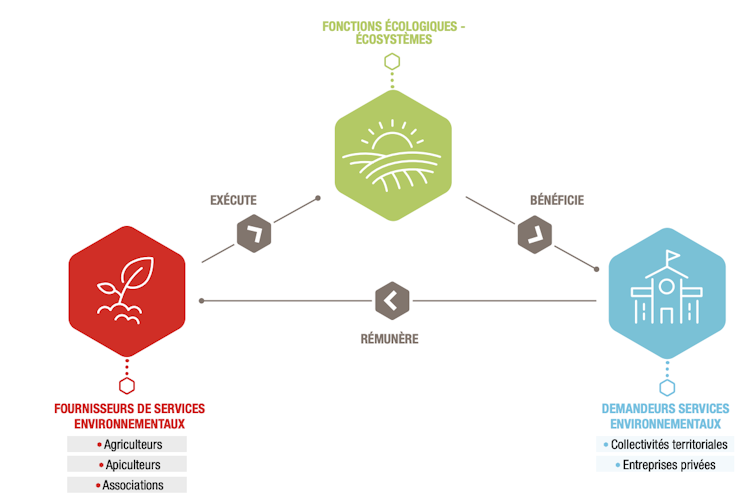Source: The Conversation – Indonesia – By Tessa Toumbourou, Postdoctoral Research Fellow in Environmental Social Science, The University of Melbourne
Our analysis of Indonesia’s social forestry permits shows that women remain underrepresented in forest management bodies despite efforts to boost their presence, leaving them out of decisions about their forests.
Social forestry redistributes forest management rights to local communities to advance sustainability and local livelihoods. In 2021, the country revised its social forestry regulations to allow one family representative to participate in social forestry management bodies, ‘giving equal opportunity to both men and women.’
However, our analysis of 400 most recent social forestry permit documents, combined with extended, multi-method field research at four sites, shows that women are often excluded from management bodies but are more involved in social forestry business groups (Kelompok Usaha Perhutanan Sosial or KUPS). These groups focus on the processing and sale of forest products.
This low level of participation in management excludes women from decisions about who receives benefits such as land for cultivation, seedlings, equipment, extension training, and technical information provided by the government and NGOs. The absence of women’s presence may deepen local inequalities and hamper effective forest management.
Gender gaps in social forestry
We reviewed the 400 most recent decree letters issued in 2024 that granted forestry management rights. These included 100 permits each for the managements of Village Forests (Hutan Desa) and Community Forests (Hutan Kemasyarakatan) and their respective KUPS (Table 1). Village Forests are rights collectively held and managed by village administrations, while Community Forests are issued to specific farmer or community groups.
Our analysis found that across Indonesia women are often underrepresented in management groups. On average, only 19.54% of members in Village Forest’s management bodies were women, with participation ranging from none to 80%. This number was even lower in Community Forests, averaging 13.95% women, with some groups having no female members and others up to 56.52%.
However, the available data often lacked details about gender in KUPS-related decrees. Only 19 of 100 Village Forests’ KUPS decrees and 23 of 100 Community Forests’ KUPS decrees included this information.
When gender data was included, women were more involved in KUPS of Village Forests, with an average of 46.32% participation. In contrast, their participation in Community Forests’ KUPS was just 13.06%.
These numbers show that progress in gender representation in Indonesia’s social forestry is mixed. While women are more active in economic activities linked to KUPS, they are still sidelined in formal management roles and decision-making.
Understanding uneven participation
Our field research also highlighted how women and men are participating in, and deriving benefits from, social forestry in Indonesia, while exploring factors influencing women’s (and men’s) involvement.
We focused on four social forestry sites — two Village Forests (Sintang; West Kalimantan province, and Muara Enim; South Sumatra province) and two Community Forests (Gunungkidul; Special Region of Yogyakarta, and Enrekang; South Sulawesi province). We selected sites that reflect different levels of women’s participation.
Table 2 highlights a disparity: while women actively engage in forest land use — such as collecting and processing non-timber forest products and cultivating social forestry land — in two sites (Enrekang and Muara Enim) they are not involved in management bodies where decisions about land use, forest resources and benefit distribution are made.
For example, Masna (pseudonym), a farmer and forest user from Enrekang, shared that her involvement in her village’s forest management body (Kelompok Tani Hutan) was limited to preparing snacks while men made decisions.
Why does this happen?
Deeply rooted gender norms significantly limit women’s involvement in social forestry in some sites. These norms often designate unpaid household and care-giving duties to women, positioning men as the primary decision-makers. This affects women’s confidence and participation in village meetings, where forest management decisions are made reduce women’s participation.
Our findings align with earlier studies showing how gender roles, influenced by discourse promoted by the New Order regime, continue to shape these practices of recognising men as breadwinners and landowners, reinforcing their dominance in formal discussions and decision-making bodies.
Although there are no educational requirements for joining social forestry, research shows that those with more education tend to have more influence. In our study, women in social forestry households averaged fewer years of education (6.6 years) compared to men (8.1 years). Lower education levels, socio-economic challenges, and low confidence in public forums, where education often boosts credibility, can further exclude women.
Geographic barriers such as remote forest locations, rough terrain, and poor roads also hinder women’s participation, making travel difficult and limiting their ability to be involved.
Assistance helps, as do local women leaders
In the Sintang and Gunungkidul sites, women have taken on greater roles in forest management bodies.
In Sintang, support from the Indonesian NGO PUPUK (Association for the Improvement of Small Business) significantly boosted women’s participation in the village forest management body. PUPUK facilitated discussions, provided training at convenient times for women, and encouraged male leaders to back greater female involvement. The number of female members increased from just one in 2018 to 12 women and nine men in a newly formed management body in 2022.
The social forestry group in Gunungkidul – initially a male-dominated, government-led reforestation project – evolved into a community-driven initiative with strong female leadership. Support from both government and NGOs enabled women to take more active roles in forestry and agriculture, especially as many men (and some women) left to seek work elsewhere.
A university-educated woman now leads this group and has inspired younger women to join forest management and KUPS activities. These include producing traditional herbal drinks (wedang uwuh) and making snacks from taro, cassava, and arrowroot grown on forest land.
Across the study sites, women involved in KUPS have developed skills in forest management, financial planning, product processing, and marketing, earning modest incomes. These activities have also shifted gender roles. For example, in Sintang, when Mirna (pseudonym) became head of the KUPS, her husband started taking on domestic chores like cooking and childcare to support her work.
What’s next?
Tackling gender disparities in social forestry requires targeted policies to ensure women’s voices, especially from marginalised groups, are heard in decision-making processes that affect their livelihoods and access to resources.
Introducing quotas or affirmative measures for forest management bodies can help close the gender gap and ensure more equitable benefit distribution. Evidence from other Global South regions suggests that at least 30% female representation in forest management bodies is necessary for meaningful participation, enabling women to influence decisions more effectively.
Inclusive governance also depends on fair representation of different ethnic and socio-economic groups, particularly poorer households. When disadvantaged groups are poorly represented, the distribution of benefits suffers, limiting the equitable flow of resources and opportunities.
Partnerships with NGOs and civil society groups skilled in addressing gender differences can empower women and marginalized men with the skills and confidence needed to engage in decision-making bodies.
Creating safe spaces is also vital. This includes holding gender-specific discussions in local languages at times that fit with both women’s and men’s schedules.
The government must also commit to regularly monitoring women’s participation by collecting and publishing accurate gender-disaggregated data, specific to each site and region.
A decree issued by Ministry of Environment and Forestry in August introduces a policy shift that allows individuals — not just groups — to apply for social forestry. This could boost women’s participation, provided targeted support helps them step into leadership roles. Without this backing, the risk remains that social forestry will continue to be dominated by elite men.
Rahpriyanto Alam Surya Putra, the director of The Asia Foundation’s Environmental Governance program in Indonesia, and Ike Sulistiowati, Director of PUPUK Indonesia, contributed to this study.
![]()
Tessa Toumbourou received funding from the Australian Department of Foreign Affairs and Trade through KONEKSI (Knowledge Partnership Platform Australia-Indonesia). The views expressed in this publication do not represent the views of the Australian Government.
Andrea received funding from the Australian Department of Foreign Affairs and Trade through KONEKSI (Knowledge Partnership Platform Australia-Indonesia). The views expressed in this publication do not represent the views of the Australian Government.
Gutomo received funding from the Australian Department of Foreign Affairs and Trade through KONEKSI (Knowledge Partnership Platform Australia-Indonesia). The views expressed in this publication do not represent the views of the Australian Government.
Ilmiawan received funding from the Australian Department of Foreign Affairs and Trade through KONEKSI (Knowledge Partnership Platform Australia-Indonesia). The views expressed in this publication do not represent the views of the Australian Government.
Lilis received funding from the Australian Department of Foreign Affairs and Trade through KONEKSI (Knowledge Partnership Platform Australia-Indonesia). The views expressed in this publication do not represent the views of the Australian Government.
Rumayya received funding from the Australian Department of Foreign Affairs and Trade through KONEKSI (Knowledge Partnership Platform Australia-Indonesia). The views expressed in this publication do not represent the views of the Australian Government.
Yulia received funding from the Australian Department of Foreign Affairs and Trade through KONEKSI (Knowledge Partnership Platform Australia-Indonesia). The views expressed in this publication do not represent the views of the Australian Government.
– ref. Indonesian social forestry often excludes women from decisions, risking greater inequality – https://theconversation.com/indonesian-social-forestry-often-excludes-women-from-decisions-risking-greater-inequality-238904














